Hundreds of people gathered at the Douglas County Courthouse Saturday to remember the September 28, 1919, lynching of Will Brown in downtown Omaha, Nebraska.
The Omaha Community Council for Racial Justice and Reconciliation, led by Omaha NAACP President Vickie Young, organized the ceremony in partnership with EJI. More than 400 community members filled jars with soil collected from the courthouse lawn. The soil will be included in an exhibit at EJI’s Legacy Museum and National Memorial for Peace and Justice.
Speakers at this community remembrance event included Ms. Young; Omaha Mayor Jean Stothert; U.S. Representative Don Bacon (R-Neb.); former State Senator Brenda Council; Omaha Police Chief Todd Schmaderer; University of Nebraska Omaha professor Cynthia Robinson; Black Votes Matter President Preston Love; and Black Votes Matter Essay Contest winner, Keyaira McKell, who read her essay.
The Reverend Daniel Hendrickson, president of Creighton University, gave an invocation. Franklin Thompson, director of the Omaha Human Rights and Relations Department, read a proclamation by Nebraska Governor Pete Ricketts.
The lynching of Will Brown by thousands of rioting white people was part of Red Summer, a series of approximately 25 “anti-Black riots” that erupted in major cities throughout the nation in 1919, including Houston, Texas; East St. Louis and Chicago, Illinois; Washington, D.C.; Elaine, Arkansas; Tulsa, Oklahoma; and Charleston, South Carolina.
“During the middle months of 1919, dozens of race riots shocked the United States,” Mayor Stothert explained. “And much to our shame, one of the worst was right here in Omaha. The riot and murder of Will Brown was the terrible end result of a collision of humanity’s failures.”
The mayor emphasized the importance of reflecting on our history of racial injustice in order “to learn, and to be shaped by that history, to recognize that enormous racial tension and suffering were part of our past, and that affects our feelings and our beliefs to this day.”
Representative Bacon is a co-sponsor of the Justice for Victims of Lynching Act of 2019, which would recognize that lynching was a tool of racial terror. “The greatness of our country is that we acknowledge what went wrong in our history, that we can acknowledge the worst chapters that we have,” he said. “Because that makes us better.”
Omaha Police Chief Todd Schmaderer acknowledged the role of law enforcement in the lynching and violence of 1919. Omaha police “erroneously arrested Will Brown, and I will say this allowed the mob to hang him,” he said. “Law enforcement and the KKK were oftentimes intermingled, and policing reflected that.”
While law enforcement has progressed since then, Chief Schmaderer said they have not come far enough, citing the criminal justice system’s disproportionate impact on people of color and the failure to hold police officers accountable for wrongful actions.
“Today’s event,” he said, “is a phenomenal event because it forces us to revisit a horrible past, look at some of the progression we’ve had, establish a plateau and move forward from there, progress even farther.”
Referring to Will Brown’s graveyard epitaph, Omaha City Councilman Ben Gray told the crowd, “We should say, ‘Lest We Forget,’ for sure. But we should also say, ‘Never Again!'”
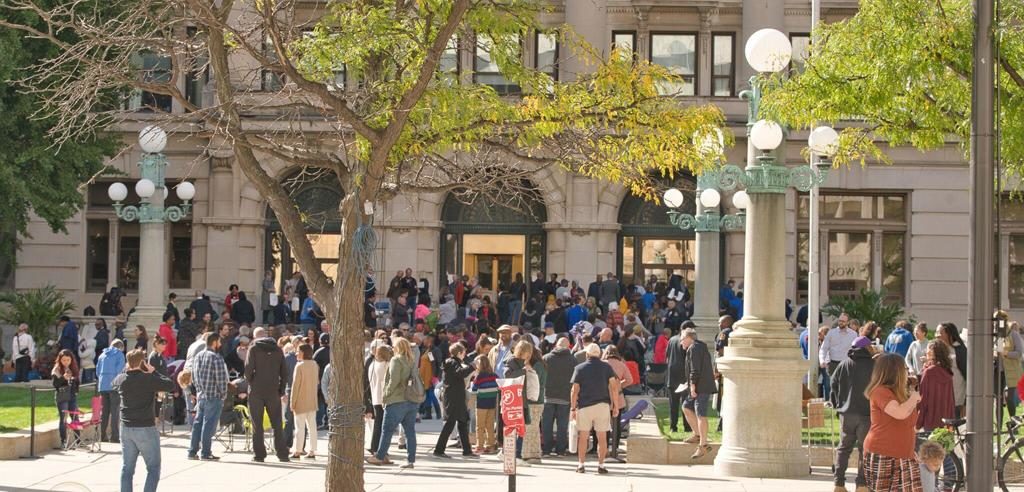
/
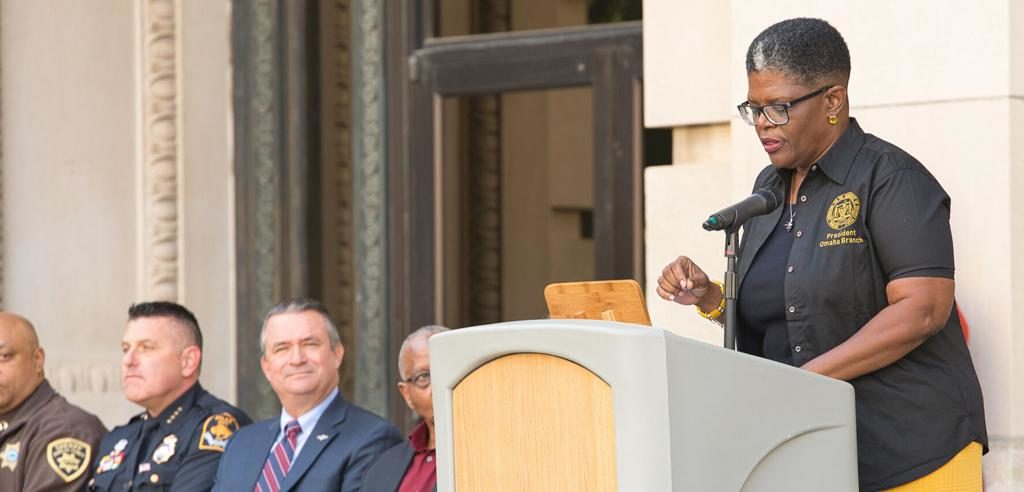
/
Omaha NAACP President and coalition leader, Vickie Young, speaks to hundreds of people at community remembrance event.
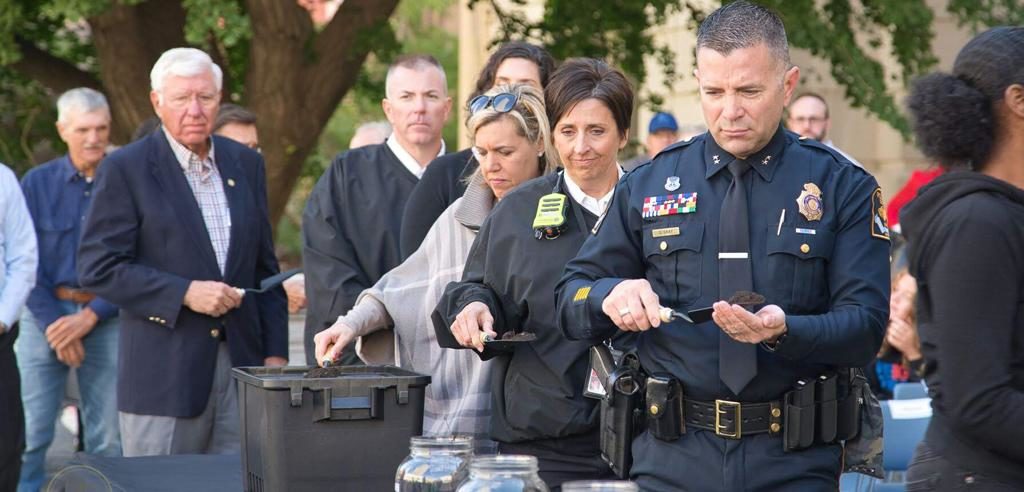
/
Omaha Police Chief Todd Schmaderer participated in the soil collection.
Taylored Media ProductionsThe Lynching of Will Brown
On September 28, 1919, Will Brown, a 40-year-old Black man, was brutally lynched by a mob of more than 5000 white people in Omaha, Nebraska. Accused of assaulting a white woman, Mr. Brown was being held at the Douglas County Courthouse when a white lynch mob broke into the courthouse, set the building on fire, and lynched him. They mutilated, burned, and dragged his charred remains throughout the Omaha community.
The deep racial hostility that permeated American society during this era burdened Black men with a presumption of guilt and dangerousness, and as a result, allegations against Black people were rarely subject to serious scrutiny.
White people’s fear of interracial sex stoked the pervasive stereotype that Black men were violent, sexually aggressive, and in pursuit of white womanhood. Accusations of “assault” extended to any action that could be interpreted as a Black man seeking contact with a white woman. Almost 25 percent of documented lynchings were sparked by charges of assault, at a time when the mere accusation of sexual impropriety regularly aroused mob violence that ended in the death of the accused.
This was true for Mr. Brown, who maintained his innocence until the moment of his death. One sheriff reported that Mr. Brown never stopped proclaiming, “My God, I never did it!” But he was denied the dignity of a true investigation or trial.
Although perpetrators of lynchings were known to law enforcement, white mobs were often allowed to act without fear of legal repercussion. In the aftermath of Mr. Brown’s lynching, a grand jury was impaneled and later issued 189 indictments. This response was rare compared to most racial terror lynchings. However, few indictments resulted in prosecution, and those were for mostly minor charges. At least two white men were charged with Mr. Brown’s murder but after brief jury deliberations, they were acquitted.
No one was ever held accountable for the murder of Will Brown, one of at least two African American victims of racial terror lynching killed in Douglas County between 1877 and 1950.
Red Summer of 1919
According to newspaper reports, in the months leading up to Mr. Brown’s lynching, approximately 25 “anti-Black riots” erupted in major cities across the nation, including Houston, Texas; East St. Louis and Chicago, Illinois; Elaine, Arkansas; Tulsa, Oklahoma; and Omaha, Nebraska. During the Red Summer of 1919, white mobs shot, burned, brutally beat, and lynched thousands of African American men, women, and children across the country.
This violence erupted during a period of intense industrial unrest sparked by the irrational fear that Black people were migrating from the South to steal white jobs in the North. In the 1900s, African Americans constituted nearly a third of those living in Southern states and less than 2 percent in other regions.
In the post-Reconstruction era, Black people occupied the lowest rung of the Southern racial caste system, relegated to sharecropping, discriminatory Jim Crow laws, extreme poverty, and brutal racial violence. Seeking safety and freedom, more than six million African Americans left the South in a steady, 60-year stream, arriving in places like Omaha as refugees of racial terrorism, only to be met with more deadly violence.
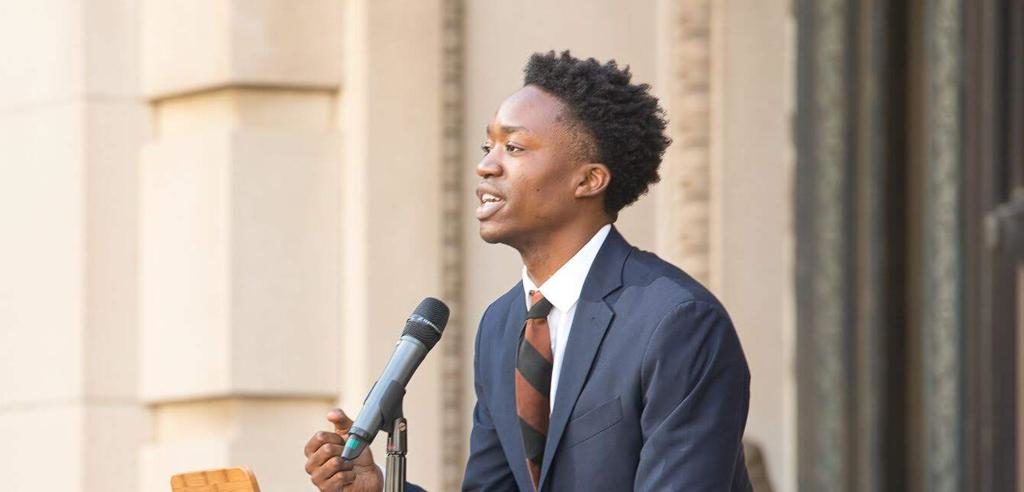
/
EJI’s Elliot Spillers spoke about our Community Remembrance Project.
Taylored Media Productions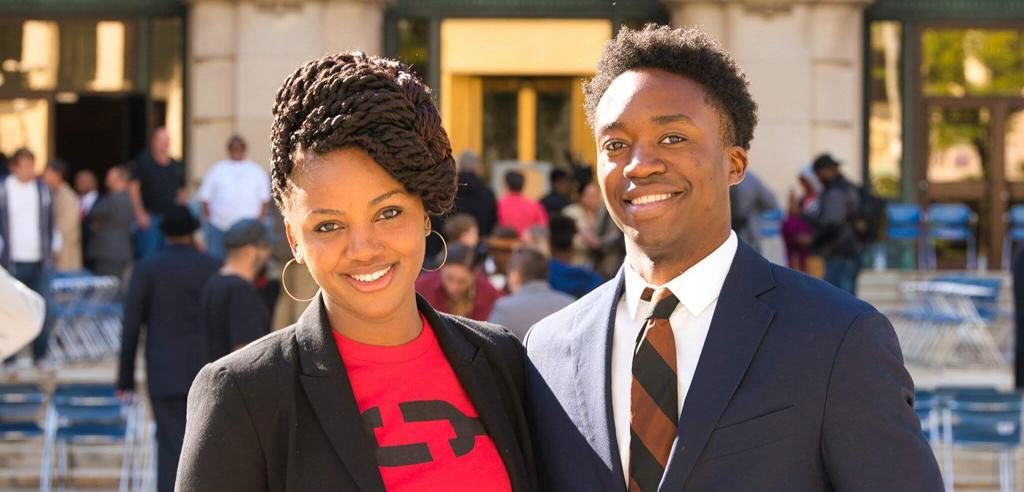
/
EJI’s Sade Stevens and Elliot Spillers helped organize the community soil collection.
Taylored Media ProductionsLynching in America
Thousands of Black people were the victims of lynching and racial violence in the United States between 1877 and 1950. The lynching of African Americans during this era was a form of racial terrorism intended to intimidate Black people and enforce racial hierarchy and segregation.
Lynching was most prevalent in the South, including Alabama, Arkansas, Florida, Georgia, Kentucky, Louisiana, Mississippi, North Carolina, South Carolina, Tennessee, Texas, and Virginia. After the Civil War, violent resistance to equal rights for African Americans and an ideology of white supremacy led to violent abuse of racial minorities and decades of political, social, and economic exploitation.
In an expanded edition of Lynching in America, EJI also documented racial terrorism beyond Southern borders, detailing more than 300 lynchings of Black people in eight states with high lynching rates in the Midwest and the Upper South, including Oklahoma, Missouri, Illinois, West Virginia, Maryland, Kansas, Indiana, and Ohio.
Lynching became the most public and notorious form of terror and subordination. White mobs were usually permitted to engage in racial terror and brutal violence with impunity. Many Black people were pulled out of jails or given over to mobs by law enforcement officials who were legally required to protect them. Terror lynchings often included burning and mutilation, sometimes in front of crowds numbering in the thousands.
In response to this racial terror and violence, millions of Black people fled the South and could never return, which deepened the anguish and pain of lynching. Many of the names of lynching victims were not recorded and will never be known.
EJI’s Community Remembrance Project
EJI’s Community Remembrance Project is part of our campaign to recognize the victims of lynching by collecting soil from lynching sites, erecting historical markers, and developing the National Memorial for Peace and Justice, which acknowledges the horrors of racial injustice.
As part of its effort to help towns, cities, and states confront and recover from tragic histories of racial violence and terrorism, EJI is joining with communities to install historical markers in communities where the history of lynching is documented. EJI believes that by reckoning with the truth of the racial violence that has shaped our communities, community members can begin a necessary conversation that advances healing and reconciliation.
